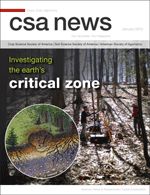January edition of CSA News features the Critical Zone Observatories
21 Dec 2011
News Source: CSA News
The January 2012 cover story of CSA News investigates the Critical Zone Observatories.
To the ordinary eye, south-central Pennsylvania's Shale Hills catchment is a pleasant little tract of deciduous forest much like any other in the northeastern United States. Second-growth oaks and maples splash dappled shade across the 20-acre site, birds flit and call, and water babbles in a narrow, unnamed stream—the first leg on a long journey to the Susquehanna River. But Pennsylvania State University geologist and SSSA member Susan Brantley is no ordinary observer; for her, the pretty scene evokes a host of questions about why the landscape looks the way it does. She’s now delving into the answers more deeply than ever before. As a co-principal investigator of the Susquehanna Shale Hills Critical Zone Observatory (CZO), Brantley is among a growing cadre of scientists who investigate the earth’s “critical zone”: the living, evolving, outer skin of our planet where rock, soil, water, air, and organisms interact to regulate the environment that is critical to life.
Interviews with Co-PI’s Susan Brantley and Henry Lin illustrate the need for Critical Zone science and observatories, specifically. As observatories are established on a global scale (in Europe, China and Australia), the hopes of a new soil science grow.
News Category:
RESEARCH |
PEOPLE |
EDUCATION/OUTREACH
Explore Further

